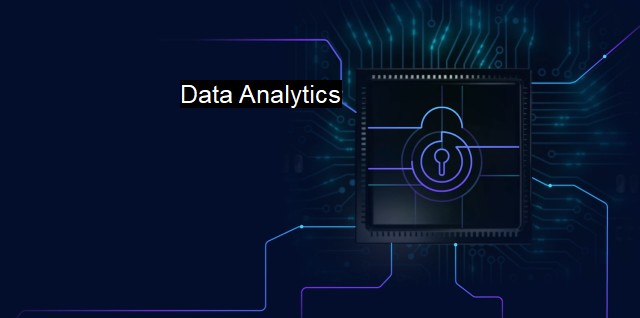What are Data Analytics?
The Vital Role of Data Analytics in Cybersecurity: Preventing Fraud and Developing Efficient Cyber Threat Detection Methods through Artificial Intelligence, Machine Learning, and Big Data
Data analytics is a crucial aspect of technology that involves comprehending various types of data. In the technology field and particularly it refers to the systematic mechanism of examining, cleaning, transforming, and modeling data to discover useful information for stipulated conclusions.Cybersecurity employs data analytics to detect and prevent cyber threats. This digital route is popular because cybercrimes such as data breaches and fraud continue to rise dramatically. The insightful use of data analytics technologies can make cybersecurity more effective and efficient.
Data analytics helps organizations stay ahead of potential cyber threats. Today's dynamic cyber landscape sees hackers continually upgrading their tactics. It makes traditional and passive defense mechanisms inefficient. Data analytics implement active defense mechanisms, such as predictive modeling and proactive security alerts. It helps enterprises predict hackers' next moves accurately, enabling them to enhance their defense systems.
Data analytics increase cybersecurity efficiency by helping reduce false positives. It helps focus security efforts on real threats rather than spend valuable manpower on false alarms. Data analytics is also instrumental in securing sensitive information, and using it to train machine learning systems can tremendously strengthen an organization's cybersecurity.
Antivirus software is another area that benefits greatly from data analytics. Antivirus traditionally relies on a virus database, comparing files and software with malware signatures. This means the latter's efficacy can waver when new or altered viral signatures emerge. The incorporation of data analytics in antiviruses replaces simple file scanning with complex detections patterns.
Data analytics, for instance, can facilitate detailed behavior analysis in antivirus programs. This includes focusing on abnormal, malicious behaviors and the recognition of new threats. It is not limited to known threats. Threat identification becomes proactive rather than reactive. It can use patterns such as location, website interaction, and file modification patterns to flag and isolate any potential malicious code at its onset.
Data analytics provide the landscape needed to build stronger, smarter, and more comprehensive antivirus solutions. Its intelligent use can inform traditional antivirus technology to improve, adapt, and evolve to modern needs. With the significant rise of malware and its increasing complexity, this evolution is timely and pertinent. It enhances the reach and efficacy, ensuring comprehensive cybersecurity coverage.
Conclusively, data analytics combines an in-depth knowledge of the nature of data and computational intelligence to forecast threats. It enables organizations to make predictive decisions, safeguard sensitive data, reduce false positives, and effectively combat cyber attacks. In antivirus systems, it ensures emphasis on actual behavior rather than mere signature anomalies.
Cybersecurity and antivirus programs leveraging data analytics are on an escalating trajectory. It is fast becoming a catalyst for change in the many dimensions of security: threat detection, identification, isolation, and removal. With radical advancements in technology and the rising sophistication in cyber threats, there is no slowing down. Actions informed by data analytics poise organizations to meet these challenges head-on both reactively and proactively.
In a broader perspective, the amalgamation of cybersecurity and antivirus with data analytics is tangible evidence that we are in a digital revolution. It hooks into a broader trend existing across all sectors for a pressing need for better, data-oriented solutions. The era of cybersecurity and antivirus aided by data analytics is certainly something to look forward to. It provides a space for constantly improving security and protection in response to the growing sophistication and number of cyber threats.

Data Analytics FAQs
What is data analytics and how is it used in cybersecurity?
Data analytics is the process of examining large datasets to uncover patterns, correlations, and insights that can be used to make informed decisions. In cybersecurity, data analytics can be used to identify potential threats, detect malware, and monitor network traffic for suspicious activity.What are some common data analytics tools used in antivirus software?
Some common data analytics tools used in antivirus software include machine learning algorithms, natural language processing, and behavioral analysis. These tools can help identify and classify threats, and can also learn and adapt over time to improve accuracy and efficiency.What is the role of data analytics in incident response?
Data analytics can play a critical role in incident response by enabling analysts to quickly identify the source and scope of a security breach. By analyzing log files, network traffic, and other data sources, analysts can trace the path of an attack and uncover any vulnerabilities that may have been exploited. This information can then be used to mitigate the impact of the breach and prevent similar attacks in the future.How can data analytics be used to improve overall cybersecurity posture?
Data analytics can be used to improve overall cybersecurity posture by providing organizations with actionable insights into their security risks and vulnerabilities. By analyzing data from various sources, organizations can identify patterns and trends that may indicate potential threats, and can take proactive measures to address these risks before they become actual incidents. Additionally, data analytics can be used to measure the effectiveness of existing security controls and to identify areas where additional security measures may be needed.| | A | | | B | | | C | | | D | | | E | | | F | | | G | | | H | | | I | | | J | | | K | | | L | | | M | |
| | N | | | O | | | P | | | Q | | | R | | | S | | | T | | | U | | | V | | | W | | | X | | | Y | | | Z | |
| | 1 | | | 2 | | | 3 | | | 4 | | | 7 | | | 8 | | |||||||